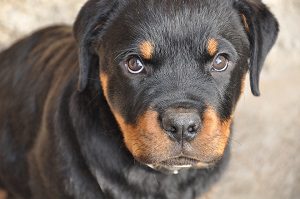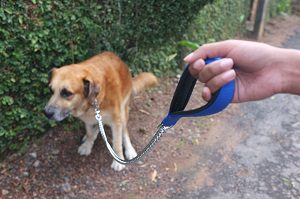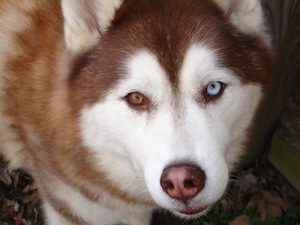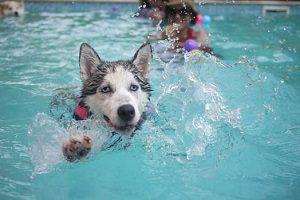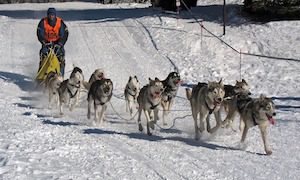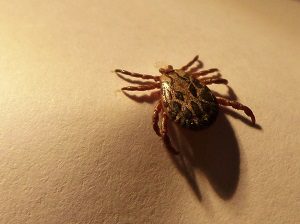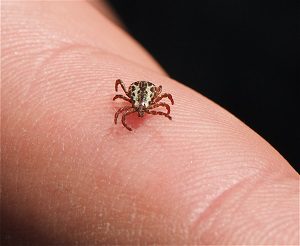Dog Breed of the Month: Poodles
August 23, 2017
Trina
If you’re looking for an energetic, kid-friendly, intelligent four-legged new member for your family, you should consider a poodle. While you may think of poodles as a Best-in-Show dog breed, they are so much more than just a beautiful dog. Poodles have a long history as water dog, a type of working dog and even their name reflects that. Poodle derives from the German word pudelin which means to splash in the water.
Poodle Features
According to the American Kennel Club, the three types of poodles – the Toy, the Miniature, and the Standard – are determined by their height and are not different breeds. A Toy poodle will be under 10 inches tall at the withers and weigh between 6 and 9 lbs. A Miniature poodle will be between 11 and 15 inches tall and weigh between 15 and 17 lbs. A Standard poodle will be over 15 inches tall at the withers and weigh between 45 and 75 lbs for a male and 45 to 60 lbs for a female.
Mini, Toy and Standard poodles coat colors can include black, white, silver, grey, blue, brown, cafe-au-lait, cream and apricot. A smaller poodles life span is typically between 14 and 16 years and a typical standard poodles lifespan is 12 to 14 years. No matter which size poodle you get, your new family member should be part of your life for a long time.
Poodle Temperament
No matter which one of the poodle types you choose, be prepared to spend a lot of time training and exercising this highly intelligent and high energy dog. Your poodle will learn quickly so be sure to have a training plan on hand- whether it’s one you’re in charge of or an obedience school you’ve signed him up for. Poodles pick up bad habits just as quickly as good ones so be on your best behavior around your new pup.
A standard poodles temperament is an easy one for new dog owners. They are generally sensitive and loyal, eager to please and not very aggressive. Your poodle might bark at a stranger but he’s only doing it to keep you, his beloved human, safe.
Because your poodle is so smart, he’ll need to be entertained lest he become bored and misbehave for attention. This doesn’t mean you need to entertain him 24/7 but it’s a good idea of keep some toys on hand for him to play with and to play with him when you are around. Smaller poodles especially can be great apartment pets as they’re able to get enough exercise indoors, running around your room or down hallways.
Poodle Grooming and Maintenance
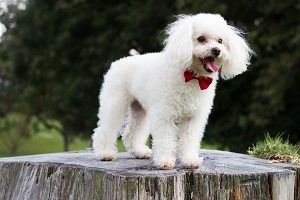 Like human hair, poodle fur never stops growing so be prepared to regularly groom your poodle every three to six weeks. If you’re an allergy sufferer, you may be wondering Do poodles shedThe answer is yes, but most of their fur collects in their coat, requiring you to brush them daily to avoid matted fur. Poodles are one of the most hypoallergenic dog breeds out there and poodles are often crossbred with other dogs. The most common poodles crosses are with cocker spaniels, malteses, labradors, golden retrievers and yorkies.
Like human hair, poodle fur never stops growing so be prepared to regularly groom your poodle every three to six weeks. If you’re an allergy sufferer, you may be wondering Do poodles shedThe answer is yes, but most of their fur collects in their coat, requiring you to brush them daily to avoid matted fur. Poodles are one of the most hypoallergenic dog breeds out there and poodles are often crossbred with other dogs. The most common poodles crosses are with cocker spaniels, malteses, labradors, golden retrievers and yorkies.
Traditional poodles grooming styles were due to their history as a water dog. Their fur needed to be trimmed so it wouldn’t weigh them down in the water but would still in insulate their bodies in the cold water. Your poodle does not have to look like a water dog or a show dog though. You can easily groom him to look like a normal dog.
Poodles do gain weight easily and will often devour everything in their bowl so it’s best to feed your poodle smaller portions twice a day and ensure he is getting plenty of exercise. Don’t leave food just sitting in his bowl or feed him table scraps, despite those pleading looks he’s so very good at giving you.
As with most breeds, poodles do have some genetic health issues you should watch for. Addison’s Disease, epilepsy, thyroid issues (both hyperthyriod and hypothyroid) and Progressive Retinal Atrophy are all issues your vet should regularly ensure your poodle doesn’t have. While this list seems long, poodles are generally a very healthy and sturdy breed so don’t panic that your new family member is going to fall terribly ill.
Poodle Fun Facts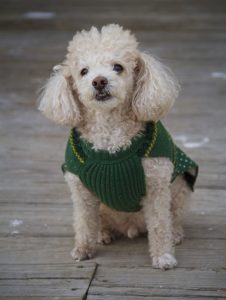
- Elvis loved poodles and gifted them to his significant others.He gave his future wife Priscilla a poodle puppy named “Honey”.
- Poodles are big sleepyheads and a standard poodle will sleep up to 13 hours a day!
- Poodles are such an old dog breed that their images are found in Roman and Egyptian art from thousands of years ago.
Whether you live in an apartment or a big home with a hard, have a large family with kids or live alone, a poodle will make a great addition to your family. This adaptable breed doesn’t need much space – just lots of love and attention.
Read more like this:
Featured DogHow to Care for an Older Dog
August 9, 2017
Craig
Your canine pal is a key part of your family life. While it can be sad to think of them growing old, it is an entirely natural process. That said, when considering dog health care, there are some helpful tips to employ and early signs that can warn you of more serious problems related to your dog’s health. Follow these tips and advice and your canine best friend will remain an active and happy part of your life for years to come.
Diet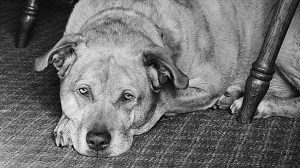
It’s not just humans who need to eat all their fruits and vegetables to be healthy! As dogs age they can become prone to bowel conditions such as constipation. Include just a small amount of fruit and vegetables in their diets however, and the extra fiber will help to stave off this uncomfortable condition – along with a bonus boost of vitamins.
The best dog food for older dogs will have a nutritional profile tailored to their specific needs. Don’t be afraid to check the labels and to add supplements if necessary. If you’re wondering how to help dogs with arthritis, prevention through diet is better than cure. Glucosamine Chrondrotin can be purchased in powder form from health food stores and added to dog food.
Arthritis in Dogs – Signs and Treatment
Sometimes no matter what you do, a dog will develop arthritis in its later years. It is important to know the symptoms so you can get your dog to a veterinarian as early as possible.
The symptoms include:
- Intermittent lameness
- Reluctance to sit up or generally walk around
- Stiffness in limbs – especially occurring immediately after exercise or a prolonged period of inactivity.
- Swollen joints and/or visible joint deformities
- Joints may feel warm to the touch
If your dog presents with any of these symptoms, book a visit to your vet immediately. There is no cure yet, but with early diagnosis, you can take advantage of a range of treatment options available which can help dogs with arthritis and minimize the pain and discomfort.
Older Dogs Losing Hair
Many older dogs may lose some hair in their twilight years – just resist the temptation to give them a comb over like Uncle Bob. Though there can be many underlying causes, Allergic Dermatitis is one of the most common. This is because older dogs can be more susceptible to allergens such as pollen, dust and chemicals from, for example, cleaning products.
Help your pal stay at his hairy best by avoiding his exposure to these chemicals and to weather extremes. Also make sure you groom him regularly, and that you use brushes and grooming tools with round teeth that don’t snag or tangle in his coat.
Heart Health
While heart disease in dogs can present with a number of symptoms, the following are some of the most common:
- Cough
- Difficulty breathing
- Reduced ability to exercise
- Loss of appetite and weight loss
- Weakness in the rear limbs.
As with arthritis, bring your pet to your dog health care provider as soon as one or more of these symptoms are apparent. There are various forms of dog heart medications that can be prescribed as well as techniques to manage, and even nullify, long-term damage. Catching heart disease early is the key to slowing, and often reversing, the damage.
Hearing Loss in Older Dogs
No, he’s not ignoring you! Dogs’ losing hearing, like humans, is an inevitable part of the aging process. While dogs will lose a certain amount of their hearing over time (this is referred to as natural geriatric nerve degeneration), hearing loss can be exacerbated by infection, injury or even a build-up of wax.
Don’t go poking about in Fido’s ears with a cotton bud, however; you will probably make things worse.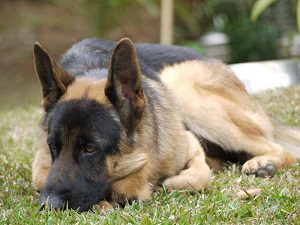
Instead, take your dog to a vet if they show any of these symptoms:
- No response to squeaking toys / clapping hands
- No response to snapping fingers behind the head
- No response to doorbells or other loud noises
- No response when called by name
- No response to other dogs
Like their human owners, dog’s bodies will change as they age, and they will naturally lose a certain degree of their abilities. But hey, can you still run around after a football like you did when you were six? Just as you know the limits of your own body so too will your dog.
It’s important to learn to help him adapt to the aging process and, more importantly, to learn to recognize the early signs of anything out of the ordinary. This will enable you to catch any serious problems early while they can still be stopped or even reversed. Follow these tips and you can maximize the time you have to love and enjoy the four-legged members of your family!
Read more like this:
Pet CareDog Breed of the Month: German Shepherds
July 26, 2017
Trina
If you’re looking for a smart, courageous and active new member for your family, you should consider the German Shepherd. They are often referred to as the true “dog lover’s dog.” Their superior intelligence makes them easy to train and they do well in households with children. In fact, these naturally loyal dogs fit in with almost any lifestyle. The most important consideration is that these agile, muscular dogs require regular mental stimulation and physical exercise.
German Shepherd Features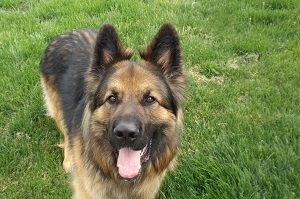
German Shepherds have a long lifespan, with some experts citing 8-10 years. Full grown males range from 24-26 inches in height and usually weigh in at 65-90 pounds. German Shepherd females are slightly smaller, usually about 22-24 inches in height. A healthy female German Shepherd weight is between 50-70 pounds. They are not generally a hyper breed and bark when only when necessary. Alertness is part of their personality and they’ll want to let you know when they spot something important you may have missed.
Mini German Shepherds are becoming popular with those who favor small breed dogs. Minis are usually German Shepherds bred with Border Collies or Poodles. If this is the case, the seller is obligated to be honest and upfront about the cross breeding. Some health issues may result from this mix. If you’re considering a Mini German Shepherd, be sure to find out what your little one’s DNA is composed of and do diligent research regarding their potential health issues.
German Shepherd Temperament
As with any other dog, temperament is a key factor in determining whether a German Shepherd will be a good fit for your family. Their protective nature and spirited disposition makes the German Shepherd an ideal guard dog. Highly intelligent, these dogs can learn many commands. German Shepherds can easily be trained for numerous canine jobs, including as a guide dog or as a therapy companion.
German Shepherd Grooming and Maintenance
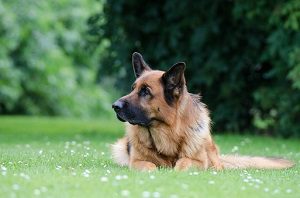 Their resemblance to wolves make for a handsome dog breed. German Shepherd coat colors and patterns range from “saddle back”, “blanket back”, and bi-colored. Some German Shepherds are multi-colored with coat hair that includes solid black, black and tan, black and silver. Another color frequently seen on this breed is a sable shade known as wolf gray. German Shepherds shed a fair amount but occasional visits to a groomer will help. Generally, these are healthy dogs with infrequent health issues. That said, you should keep an eye out for signs and symptoms of hip and elbow dysplasia and eye diseases.
Their resemblance to wolves make for a handsome dog breed. German Shepherd coat colors and patterns range from “saddle back”, “blanket back”, and bi-colored. Some German Shepherds are multi-colored with coat hair that includes solid black, black and tan, black and silver. Another color frequently seen on this breed is a sable shade known as wolf gray. German Shepherds shed a fair amount but occasional visits to a groomer will help. Generally, these are healthy dogs with infrequent health issues. That said, you should keep an eye out for signs and symptoms of hip and elbow dysplasia and eye diseases.
Experts emphasize that color and pattern are the last thing potential owners should make a fuss about. Your puppy’s vitality, good health, and athleticism are much more important. New owners are advised to realistically judge whether your household space can accommodate the needs of a German Shepherd. You should also be sure everyone in the family is prepared to feed, walk, and interact daily with this new addition.
German Shepherd Fun Facts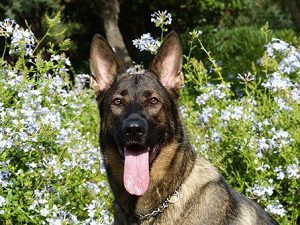
- German Shepherds became very popular in the United States in the early 1900’s in the state of Illinois.
- At the time, their popularity was boosted by the long-forgotten canine movie stars, Rin-Tin-Tin and Strongheart.
- German Shepherds are the globally preferred breed for police and military K-9 units.
- In February 2017 the Westminster Kennel Club Dog Show awarded Rumor, a German Shepherd, best in show.
A German Shepherd will consider your family and home as his pack and territory. A German Shepherd will be generally fearless and once he bonds with his humans, it’s for a lifetime. As long as you as his owner take the time to train him, to show him love and affection, and to respect your new family member, this will be a lifelong wonderful relationship.
Read more like this:
Featured Dog7 Essential Commands for Your Dog to Learn Now
July 12, 2017
Trina
One of the first questions to cross a new dog owner’s mind is how to train your dog. I like to think of this process in two phases. First, and most critically, should be teaching your new pup the essential commands that will help keep him safe in most situations. Second, and this is the fun part, teaching your dog the tricks that both he and your family will enjoy. Something that too often goes unsaid is that training can be a valuable bonding experience between a dog and his humans. As such, it is hugely important that all members of the family take part in the training. Whether in a teaching or reinforcing role, participating in training these common dog commands serves as a critical building block of respect and love between you and your dog.
The 7 Most Common Dog Commands are….
- Sit
- Stay
- Come
- Drop It
- Heel
- Play Dead
- Roll Over
Let’s cover the essential commands that will safeguard your best friend in many potentially dangerous scenarios. Your very first training effort should always be to teach a dog to sit, stay and come. Yes, these are three distinct commands, but most trainers will tell you that they should be taught in unison. They will also almost unanimously tell you that teaching a puppy to stay is the most important lesson he’ll ever learn. Other valuable steps in proactively protecting your puppy, are teaching him to drop it and learning to heel your dog.
Often some of the traits that we treasure most in our dogs can be the same behaviors that put them at risk in certain situations. Imagine you’re arriving home from work and your pup is watching over your children in the park across the street. As soon as you come into his view, all he knows is that another one of his favorite people has returned from the most recent unbearably long absence. He’ll want to smell where you’ve been and to tell you all about his day. While you’re obviously excited to see him as well, what you notice and he doesn’t, is that your neighbor is arriving home as well and can’t hear you with the windows up. In that instant it is invaluable to know that no matter what else is occupying his attention as he nears the street, your command to sit and stay will break through and result in him immediately complying and possibly saving himself from unthinkable harm.
Close relatives to the sit and stay commands are come and heel. Again, one of the things we love most about our dogs is their unbridled enthusiasm for all things fun. Unfortunately, at times those things can lure our furry friends into an impromptu chase. Before you know it, he’s a football field away from you in some dense brush. In this situation, it sure is nice to know that even though he can’t see you, he’ll still hear your voice and come trotting when asked. Heeling may not be the most important of commands related to safety, but the skill is a valuable social tool. As shocking as this may seem to you and me, not everyone is comfortable around dogs. When encountering one of these unfortunate souls during a walk, the ability to heel your dog benefits everyone.
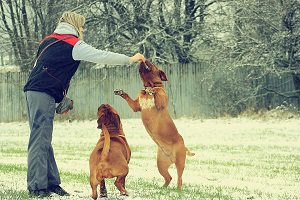
Bringing a close to safety commands, you’re also going to need to teach him to drop it when requested. Again, our best buddy’s enthusiasm (and relentless desire to chew), can put him in a vulnerable spot. There may come a time when he has trouble discerning between a new toy and a prescription bottle that was inadvertently knocked off the kitchen counter. You’ll sleep better knowing that if this sort of quandary ever presents itself, both you and your dog are prepared.
Now that we have the essential commands out of the way, you can begin teaching some of the more advanced dog tricks everyone loves. The possibilities here are limited only by you and your dog’s imagination, but some good building blocks are teaching a dog to play dead and roll over. These are fun tricks he can impress his friends with while proving useful to you at the same time. Cleaning your boy’s ears can be a challenge as it clearly won’t be one of his favorite activities. Having mastered these two commands can make that task easier on both of you.
Try not to look at training as a task so much as to view it as an opportunity to protect your new family member, while at the same time bringing him closer together with his new family. You’ll all be happier for the experience, the results and the memories!
Read more like this:
AdviceDog Breed of the Month: Beagles
June 28, 2017
Trina
 Beagles are a member of the Hound Dog family, a class of dogs historically tasked with tracking and hunting. Beagles, as we know them today, can be traced back as far as 1800’s England where they were primarily used to flush out rabbits. Their heritage has been etched into various versions of The Fox Hunt paintings, depicting the hunting hounds from which they descend. How many people can say that their dog’s ancestors are included in works of art that hang in museums all over the world? They made their way into American hearts when a breeder from Illinois brought them to the United States, and have since become known as one of the most loving and loyal breeds.
Beagles are a member of the Hound Dog family, a class of dogs historically tasked with tracking and hunting. Beagles, as we know them today, can be traced back as far as 1800’s England where they were primarily used to flush out rabbits. Their heritage has been etched into various versions of The Fox Hunt paintings, depicting the hunting hounds from which they descend. How many people can say that their dog’s ancestors are included in works of art that hang in museums all over the world? They made their way into American hearts when a breeder from Illinois brought them to the United States, and have since become known as one of the most loving and loyal breeds.
Beagle Features
Beagles typically grow to between 20 and 30 pounds. Most have a short, smooth tri-color (white, black & tan) coat, but two-color coats (usually white & tan) are not uncommon. Some tri-color beagles will lose their black markings as they age. They are also bred in two different sizes and both can be present in the same litter, so if you’re intent on one over the other, you’ll need to wait about nine months to bring home your newest member of the family.
Beagle Temperament
Beagles are an affectionate and loyal breed, making them excellent family dogs. Along with loyalty though, can come some pretty stubborn behaviors.
As with most hunting dogs, their sniffers are the center of their universe. As such, they can override everything at times. Yes – even the repeated and reasonable requests of their parents! Most trainers with experience will tell you that the key to working with beagles is to make everything into a game, enabling you to hold his attention long enough to learn what you’re asking of him.
Beagles are a pack breed and typically become very attached to their humans. As such, they are an excellent addition to families with children.
If you’ve done any research into beagles at all, you’re probably aware of the fact that they love to “talk”. Their reputation for being vocal leads to some common concerns on the part of potential owners. Do they bark a lot? Do beagles howl? The answer is that they do employ some very distinct sounds, from barking to braying, for different situations and yes, they do like to howl. They also love food, even more than most dogs. For these reasons, you’ll need to keep a vigilant eye to be sure “people food” is kept out of your beagle’s reach. On the flip side, their love of food can be a plus when training. A beagle will do just about anything you ask if you’re holding a treat.
All of these potentially negative tendencies can be curbed simply by making sure your beagle is never bored. Having a household with children or another dog to play with and plenty of toys is a happy place for most beagles.
Beagle Grooming and Maintenance
It’s critical to remember that as hunting dogs, beagles definitely need their exercise. You’ve no doubt encountered those poor pups that are cooped up in apartments and have “put on the pounds” as a result. If you’re interested in owning a beagle, please be sure your lifestyle can accommodate frequent walks or your budget can accommodate a regular dog walker. When can you carve out the time, a walk with a beagle is typically a very relaxing experience for the parent on the other end of the leash. Beagles live to investigate the world through smell, so you can expect long casual walks with lots of stops along the route.
A fenced-in or perimeter-controlled yard or an off-leash dog walker is also a must! The inner hunter loves to explore and their sniffers will lead them away in a single-minded chase if they’re not in some way prevented from doing so. That same one track mind can also lead to selected listening, so don’t hold it against him if he’s too busy tracking to come to your calls.
Like many breeds, beagles do have a few genetic health issues to keep an eye out for as your beagle ages. Among them are hip dysplasia, diabetes and seizure disorders. It’s impossible to tell whether or not these are areas of concern for a particular puppy, so it’s important to ensure your chosen breeder is reputable and has solid references.
Do beagles shed a lot? While they do shed year-round, a good brushing a couple of times a week will keep the household “fallout” to a minimum. In general, beagles definitely fall on the low maintenance side of the grooming spectrum.Unless he’s found something fun to roll in, a bath every three months or so should be sufficient. Along with their cute floppy ears, comes a heightened responsibility to keep them clean. Finally, as with most breeds, you’ll need to keep his nails trimmed to the point where you can’t hear them clicking on the floor.
Beagle Fun Facts
- Beagles are frequently employed by the US Department of Agriculture. They undergo a three-month training program and help to patrol airports across the country for weapons, drugs, and foods that could carry dangerous insects or diseases.
- While your beagle will undoubtedly be the world’s most adorable, they still have some famous shoes to fill. Beagles have roamed the grounds of the White House and are a huge part of popular culture. Snoopy (Peanuts), Mr. Peabody (Rocky and Bullwinkle) and Odie (Garfield) are some of their more famous tinsel town extended family!
When you bring a beagle home, you are literally adding a new member to the family. He will become fiercely attached to his new pack, so please be confident in your decision. Just like many humans we all know, he can be stubborn and willful. That dedication and enthusiasm will also shine in his love for you, though. Would we really want it any other way?
Read more like this:
Featured DogBrushing Your Dog’s Teeth: Oral Care for Canines
June 14, 2017
Craig
According to a study from 2013, 78% of dogs above age three suffer from bad breath, making it the most common health problem affecting dogs. While the prevalence of oral health issues is quite alarming, what’s more concerning is that a significant number of owners have not taken the adequate action to address the situation. Most dog owners consider bad breath to be just a thing dogs have, but poor oral health can lead to serious medical conditions which can adversely affect your dog’s liver, kidney and lungs. It is incredibly important as a dog owner that you adopt a good dental hygiene routine for your dog. Doing so will protect more than just your dog’s teeth.
Brushing Your Dog’s Teeth
The well-known saying “An ounce of prevention is worth a pound of cure” is very apt when dealing with your dog’s dental problems. Brushing your dog’s teeth regularly is a key part of dog dental care and will save you a ton of trouble down the road.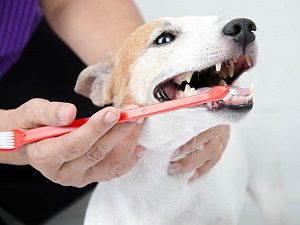
Conventional wisdom tells us that dogs have cleaner mouths than humans and are not as prone to cavities. But dogs can still develop tartar and plaque which can lead to dog tooth decay and gingivitis. To prevent this, regular brushing is highly recommended. Done incorrectly, brushing your dog’s teeth could be a very unpleasant experience for both of you. But here a few tips to follow to make the experience a lot more pleasant:
-
Start brushing your dog’s teeth as early as possible
Instilling a good dental care routine for your dog should ideally start when your dog is still a puppy. Puppies will have their full set of teeth when they are 8-10 weeks old. Don’t start by using a toothbrush; Use your index finger instead. Just put some dog toothpaste on your finger and gently massage his gums. Your dog will be more comfortable using a toothbrush if you first acclimate him to brushing with your finger.
-
Pick the right toothpaste for your dog
NEVER use human toothpaste for your dog as it will contain fluoride which is highly poisonous to dogs. Choosing the right flavor is very important as not all dogs like the same sort of toothpaste. Plan to try a few different types until you find the one your dog most enjoys.
-
Introduce the toothpaste gradually to your dog
When you’ve picked the toothpaste, have your dog lick it and get accustomed to the flavor so that brushing becomes easier.
-
Develop a routine
Brush your dog’s teeth when he’s calm and relaxed. The goal is to be able to set a specific time for the activity, perhaps shortly after he sees you brushing your teeth.
Dental Care Dog Foods
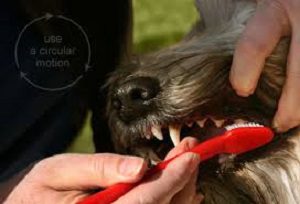 Maybe you don’t have the luxury of time to brush your dog’s teeth every day. Maybe you both hate the experience so much that doing it every other day feels like all you can handle. Or perhaps you just want to do a little extra to ensure your dog’s good oral health. Whatever the situation may be, you can supplement your dog’s dental hygiene through a special dental diet. While there are plenty of products in the market that claim to be dental care dog food, before buying any, you should look for the seal of approval for the Veterinary Oral Health Council (VOHC). You can check their website for a complete list of VOHC accepted products.
Maybe you don’t have the luxury of time to brush your dog’s teeth every day. Maybe you both hate the experience so much that doing it every other day feels like all you can handle. Or perhaps you just want to do a little extra to ensure your dog’s good oral health. Whatever the situation may be, you can supplement your dog’s dental hygiene through a special dental diet. While there are plenty of products in the market that claim to be dental care dog food, before buying any, you should look for the seal of approval for the Veterinary Oral Health Council (VOHC). You can check their website for a complete list of VOHC accepted products.
Dental care dog foods are required to have the same nutrient content as regular food but have added ingredients to help clean a dog’s teeth. Humans are told to eat carrots because they help clean the gunk off our teeth. In the same way, Kibbles and treats that are made for dental diets are larger in size and have a fibrous texture which breaks easily. The edges then scrub the teeth of your dog as he chews.
While dental diets have all the nutrients needed for a normal daily diet, you shouldn’t run out and switch your dog completely over to these dog food brands. Your dog may not be able to tolerate a diet comprised exclusively of dental food so to be safe, start by introducing the dental diet dog food and slowly increasing the amount.
Other Dental Care Products for Dogs to Consider
There are other doggie dental care products that will help protect your dog’s dental health. Chlorehexidine can be used as an oral cleansing agent to address dog dental inflammations and infections. Aside from the bitter taste, it has no known side effects. Dogs can also benefit from chewing on bones as a natural remedy.
While dog dental care products help, it is also important to schedule regular visits to your veterinarian. The veterinarian will be able to assess if the overall dental health of your dog and recommend solutions should there be problems identified.
Putting in the effort to take care of your dog’s oral hygiene can be daunting but this will lead to a healthier and longer life for your beloved companion which makes it all worth it.
Read more like this:
Pet CareDog Breed of the Month: Rottweilers
May 24, 2017
Trina
Rottweilers are a member of the Working Breed Group. Like most members of this group, Rottweilers are uncommon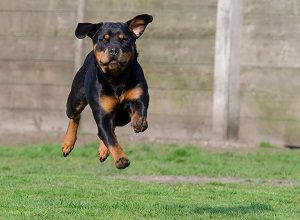 ly intelligent and loyal. Other shared traits include their large size and formidable strength. The rottweiler’s history can be traced back to early Roman times where they were originally bred to herd cattle and pull farm carts. Later, they were taught to perform more aggressive duties such as bear hunting, if you can believe that!
ly intelligent and loyal. Other shared traits include their large size and formidable strength. The rottweiler’s history can be traced back to early Roman times where they were originally bred to herd cattle and pull farm carts. Later, they were taught to perform more aggressive duties such as bear hunting, if you can believe that!
Rottweiler Features
Given the right circumstances, rotties can grow to be more than 100 pounds. The rottweiler’s short and smooth fur accentuates an already muscular frame, leaving an intimidating impression on most. Their imposing size, combined with their distinctive black-and-tan coloring, makes them one of the most recognizable breeds.
Rottweiler Temperament
Proper breeding and training are a must when considering a rottweiler for your family. Unfortunately, occasional misguided and uneducated training has left them saddled with an unfair reputation. That being said, as a rottweiler owner you are taking on a serious responsibility. Any dog, especially one with the size and strength of a rottie, warrants respect. However, the loyal and protective nature of these dogs demand extra care and caution in their training.
Rottweilers are uniquely dedicated to their family, but it’s not uncommon for them to bond with others they are frequently exposed to as well. On the same note, they’ve also been known to attach themselves more strongly to a single member of the family. Most are very loving and can’t wait to cuddle. Like people, they do have very distinctive personalities and tendencies. You should be prepared for each of these eventualities presenting itself and possibly differing even within the same litter.
Are rottweilers good with kids? Absolutely, but while they will bond quickly with your children, it would be short-sighted to assume your rottie will deal with other children the same way. His protective nature could interpret normal play behavior between children as a threat to those he loves, posing obvious behavioral risks. His heritage as a herder can also pose challenges in homes with small children or the elderly. At more than a hundred pounds, what he sees as a playful nudge can end badly for someone with balance issues. Certain rottweiler traits can make a rottie a great part of your family when he is raised properly, but rottweilers do require an extra level of vigilance on the part of their humans. For these reasons, you should strongly consider professional training.
The breed isn’t normally known for being very vocal, so your rottweiler’s barking should be investigated. Chances are he’s spotted something he perceives as a threat to his humans. As such it warrants your attention either to address the issue or to let him know all is still right with the world.
Rottweiler Grooming and Maintenance
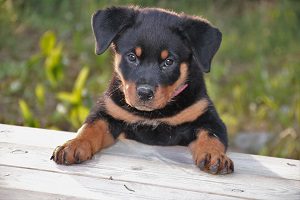 Many people stereotype rottweilers as single-minded guard dogs when the opposite is true. Rotties are very much a thinking breed, so it’s critical to remember that they are happiest when they have a job to do. In addition to a normal walking schedule, it’s especially important to play games with your rottie. Playing fetch or hide-and-seek with your pup frequently will make him feel like a valued member of the family. He needs a sense of purpose so even during those unavoidable busy stretches in your life, be sure to at least run him through his set of learned commands on a daily basis.
Many people stereotype rottweilers as single-minded guard dogs when the opposite is true. Rotties are very much a thinking breed, so it’s critical to remember that they are happiest when they have a job to do. In addition to a normal walking schedule, it’s especially important to play games with your rottie. Playing fetch or hide-and-seek with your pup frequently will make him feel like a valued member of the family. He needs a sense of purpose so even during those unavoidable busy stretches in your life, be sure to at least run him through his set of learned commands on a daily basis.
Rottweilers have what is known as a double coat. They have a dense outer coat and a softer undercoat around the neck and thighs, the thickness of which can change depending upon the climate he lives in. Do Rottweiler’s shed? They do, most heavily during Spring and Fall, so it’s important to brush him at least once a week during those seasons. Bathing requirements are more relaxed though. Depending on personal preference, you can bathe your rottie only when he’s noticeably dirty or as often as weekly without damaging his coat.
Rotties do slobber, especially while drinking or immediately following a meal. Some extra care around his feeding station and environment can mitigate this trait though.
Their average weight and their genetic characteristics leave them vulnerable to hip and elbow dysplasia. They are also prone to obesity, which accentuates the risk of the former. Thankfully, obesity is the one thing you as his human can easily protect him from by taking it into account when figuring out his diet. A rottweiler’s life expectancy is typically 8 to 10 years. Caring for their unique needs will help to protect them from avoidable health issues and ensure many happy memories!
Rottweiler Fun Facts
- A rottweiler’s bonding tendencies and protective nature earn them a place near the top of recommended breeds to serve as service dogs and they’ve even been employed in search-and-rescue roles.
- At one point in their history, the rottweiler was actually at risk of extinction. When cattle driving was briefly outlawed in Rome and they were replaced by donkeys as the prefered carting animal, their numbers fell dramatically. If not for the quick thinking of a club formed to protect the breed in the early 1900’s, we might have lost the breed forever.
Rottweilers aren’t for everyone, but their protective nature and strong bonding traits are obvious draws for many families. What sometimes gets overlooked though, is the deep and intricate nature of a rottweiler’s personality. Don’t be surprised if you observe a sense of humor in your pup. He is eager to please and impress and will even resort to what could be considered “goofy” behavior if he senses someone could use a pick-me-up. Bringing a rottie into your home is like adding a family member in every sense of the phrase!
Read more like this:
Featured DogHow to Potty Train Your Puppy
May 10, 2017
Craig
Figuring out how to potty train your dog fast isn’t easy and will require some hard work. While it can appear to be a daunting and arduous task, potty training a puppy can be manageable with persistence and consistency. You’ll find that establishing a routine is key when learning how to potty train a dog fast. You just have to remember that the routine you set in the beginning stages is the key to training success, saving you from a grim future of cleaning up their soiled messes on your indoor flooring time and time again.
There are multiple methods teaching you how to potty train a puppy. Two of the most popular are crate training and outside training. We will explore both in depth so you can determine what will work best for you and your puppy.
Crate Training
Experts suggest that you begin potty training your puppy between 12 and 16 weeks of age. At this age, he will have enough bladder control to begin a routine. When crate training, choose a crate that is large enough for your puppy to turn around, stand and lie down in. Note that a crate which is too large will allow the puppy to use the bathroom on one side, while still keeping his bedding area clean on the other side. This will hinder the training process and the association to go to the potty outside, not in the crate or your home.
The crate should be a welcoming environment, padded with a blanket and maybe a toy or two. You want your puppy to enjoy his crate time. In the beginning, bring your puppy to his crated area during times of rest for short intervals, starting with about 15 minutes and increasing from there as he gets older. After the allotted time is up, take your puppy out of the crate and bring him outside to use the bathroom. The key is for him to realize that after crate time comes potty time. Once he does use the bathroom, heap on the praise and feel free to reward him with a treat. Repeat this routine consistently throughout the day.
In the evenings, make sure to remove his water source about 2.5 hours before his bedtime. Take him out one last time before bed. Remember that you’ll have to take him out to use the bathroom again during the night if he wakes up. This is to ensure he doesn’t have an accident in the crate during those nighttime hours. After a few months, he should be able to have enough control of his bladder to make it through the night.
Outside Training
Just like crate training, establishing a routine is essential for potty training your puppy outside. In the early stages of training, it’s best to take your puppy outdoors frequently. At least once an hour will ensure you are setting your puppy up for success. Don’t forget to take your puppy outside when he wakes up from sleeping and after playing, eating, and drinking.
Set up an eating schedule for your puppy and pay attention to any signs he needs to go after he is done. Regardless, he should be taken out immediately after his meal even if he doesn’t show any obvious signs of having to go. Every dog is different, so it may take multiple trips outside before you can figure out how to house train a puppy. You will need to be vigilant to determine how soon he needs to use the bathroom after eating. Again, remove his water source 2.5 hours before bedtime and pay attention if he wakes up during the night, taking him out right away if he does.
When taking your puppy outside, pick a location for him to use as his potty and stick with that same area every time. Once he goes, praise and reward him for his efforts immediately after he is done so he can associate what he has done with the positive attention you’re giving him.
With both crate training and outside training, don’t expect your puppy to be perfect after the first day, week or even month. Expect mistakes and when they do happen, clean up the mess without complaint. If you catch your puppy starting to go, pick him up quickly and take him outside. Punishing a dog after the fact is useless and will only result in a confused look as they can’t connect the fact they’re being disciplined with their natural need to potty.
With some patience, consistency and lots of love and praise, you can be sure you’ll be well on your way to house training your puppy fast. Keeping in mind that building a trusting relationship will also enable you to quickly master how to successfully potty train your puppy. Stick with it, have patience and all your efforts will quickly be rewarded.
Read more like this:
AdviceDog Breed of the Month: Siberian Huskies
April 19, 2017
Trina
If you shouldn’t judge humans by their physical appearance, you also shouldn’t love a dog based on their coat. However, it’s hard not to fall in love with a Siberian Husky, which has one of the most gorgeous, thick coats among the many dog breeds. Affectionate and kid-friendly, these dogs also tend to break the stereotype of large-looking dog breeds being noisy and unsafe. For this alone, the Siberian husky deserves to be the dog of the month.
What Is a Siberian Husky?
Based on its medium frame, you would immediately guess it’s a guard dog. You’d be wrong. The Siberian Husky is a sled dog, along with its relatives which include the Greenland Dog, the American Eskimo dog, the Labrador Husky, the Alaskan Malamute, and the Akita.
The history of these huskies began around 3,000 years ago in a Russian peninsula where the Chukchi people lived. The Chukchi tribe is nomadic, and they live mostly by hunting and gathering. To help them navigate through thick ice, they rely on Siberian Huskies. For this reason, Siberian Huskies are also called Chukcha dogs.
The breed arrived in North America, particularly in the United States, during the early years of the twentieth century when they competed in the All-Alaska Sweepstakes races. About 21 years later, the American Kennel Club (AKC) recognized the breed.
Siberian Husky Appearance
Most people think Siberian Huskies are either black or white with few markings on the heads and that they have the most gorgeous set of blue eyes. These dogs, in reality, can come in a wide variety of colors that include reddish brown (sable), cream (agouti), pale yellow to light orange (light red), dark red (copper), and gray (wolf gray). Their eyes can also be brown and some Siberian Huskies have both brown and blue eyes. Oddly, some Siberian Huskies can be parti-eyed, which means their eyes can have two colors.
They are generally medium framed and can measure up to 23 1/2 inches at the withers (female dogs can be smaller by an inch) and weigh between 35 and 60 pounds, depending on the gender. Although the body appears stocky, Siberian Huskies generally have a proportional height and weight.
One of its main features is its coat. The undercoat is dense while the top coat is smooth, making the Siberian husky really fluffy and furry.
Siberian Husky Temperament
Siberian huskies can have the loudest barks and strongest growls, but overall, they are incredibly affectionate and lovable. After all, their ancestors used to sleep with the Chukchi families, especially their kids, to help them keep warm. Yet unlike other affectionate breeds, they are independent. As they can take their independence seriously and wander, you need to be aware of where they are, especially in areas with high traffic. Siberian Huskies generally get along with other dog breeds, other animals, and other people, which means you shouldn’t expect this dog to guard your home.
Based on their ancestry, Siberian Huskies are active, alert, and agile. They are the perfect personification of endurance but because of these same characteristics, they require a lot of space to move around, making them not suitable for apartment dwelling.
Siberian Huskies are fun dogs, and they definitely love to play. But since they are independent and don’t require your engagement to be happy, they can have issues with obedience. It’s not impossible for them to go back to their original habits after training, so you need to be very patient with them and keep the training constant.
Siberian Husky Health and Grooming
The amount of hair they shed depends on the climate you’re in. If you live somewhere tropical or humid, especially during spring and summer, expect to deal with a lot of hair. However, if you live somewhere more temperate, like the Bay Area, you won’t have as much clean-up to do. No matter the climate, a Siberian Husky’s coat requires weekly grooming and daily brushing of the coat.
Siberian Huskies live an average of 12 to 15 years, but they’re not prone to a lot of health issues. Some of the common diseases that can develop among the breed usually affect their eyes such as glaucoma and progressive retinal atrophy. Bigger health issues are not common.
Siberian Husky Fun Facts
- Siberian Huskies played a huge role in treating diphtheria that struck Nome, an Alaskan village, in 1925. A team of Siberian Huskies traveled more than 600 miles in six days to get the much-needed serum from a train stop in what is now known as the Great Race of Mercy.
- One of these heroes, Balto, is now immortalized in Central Park.
- The color of their coat determines the color of their nose.
- These dogs hardly smell, and they don’t require much bathing.
Siberian huskies are not for everyone. Their self-sufficiency and independence may frustrate first-time dog owners while their size and need for large spaces may demand a more spacious dwelling. But these potential downsides pale in comparison to the sweetness, affection, friendliness, and gentleness this dog exhibits. They don’t require extensive grooming and their sense of endurance make them even more worthwhile pet companions. So don’t hesitate to rescue or adopt a Siberian Husky. You may have to put some work into training etc for a while, but the rewards for your effort will be repaid in spades.
Read more like this:
Featured DogLyme Disease and Your Dog: Prevention and Treatment
April 5, 2017
Craig
For canine aficionados, our dogs are the best companions when walking and enjoying the outdoors. While we love their contagious energy, it also means they need regular exposure to their natural environment. Unfortunately, this very same seemingly safe milieu is the source of one of the most common illnesses that affect man and his best friend: Lyme disease.
The good news is, Lyme disease in both humans and dogs is both easily preventable and highly treatable. As long as you know what is Lyme disease in dogs, the signs to look out for and various treatment options, you are your canine best friend should be just fine.
What is Lyme Disease in Dogs?
Lyme disease in dogs is caused by the bacteria Borrelia burgdorferi (Bb) found in ticks. It is an infectious, vector-borne disease that is prevalent in areas of the United States with high human and pet populations, such as the Pacific coast, the Northeast and the Midwest. The disease is transmitted when the Bb-carrying ticks feed on animals.
Lyme disease is common in dogs because these bacteria-carrying ticks are so tiny they are difficult to notice. The disease will only affect your dog if the tick is attached to it for about 48 hours. If within that period of time, a tick dies or is removed from the potential host, the Bb bacteria it could be carrying will not be transmitted.
Because every fun minute our dogs spend with Mother Nature renders them increasingly vulnerable to ticks, we must be well-informed and take some precautions to protect them from tick-transmitted diseases.
Symptoms of Lyme Disease in Dogs
So how do we know if our beloved pets have been preyed upon by these microscopic Borrelia-borne disease-carriers?
Lyme disease symptoms in dogs include a sudden onset of arthritis, lameness, loss of appetite and weight, and lethargy. What makes Lyme disease challenging for some people to detect and address is that the symptoms appear only in 5-10% of affected dogs. So your dog could actually be breeding Lyme (first discovered in Lyme, Connecticut in 1975) without you knowing it.
According to the Center for Disease Control and Prevention (CDC), signs of tick-borne diseases may not appear for 7-21 days or longer after a tick bite, so do closely monitor your dogs if you think they have been bitten by a tick.
It would be wise to contact your veterinarian immediately if your dog is experiencing any of these symptoms. If left untreated, Lyme disease could lead to kidney failure. Warning signs of a more serious condition include vomiting, thirst, diarrhea and increased urination.
Preventing Lyme Disease
The best way to prevent Lyme disease from affecting your dogs is to keep them from roaming around in tick-infested areas where this illness is common. If possible, avoid these environments especially during periods when ticks are most active.
On a daily basis, check your dog’s coat and tail for ticks. Try to remove them all by hand. Note that ticks carry other diseases besides Lyme disease, so their immediate removal from your pets protects them from acquiring other illnesses as well.
There are solutions such as sprays and topical products in the market that can effectively kill and repel ticks. Keep an eye out for the ingredient Permethrin. When applied to your dog (must NOT be used on cats), the tick that attached to it dies within 12 hours, halting transmission of the B. burgdorferi. Another reliable ingredient is Fipronil. As for tick collars, look for one that contains amitraz – an organophosphate that can instantly kill ticks but is not as helpful in combating fleas.
Vaccination is recommended only for dogs in areas where Lyme disease is common. This is also advisable for dogs that were infected once with B. burgdorferi, because they can still contract the disease. Even vaccinated animals are still at risk so vaccinating your dog doesn’t mean you get to be careless.
If you decide to try any of these products, please check with your veterinarian first.
How to treat Lyme Disease in Dogs
So what if your dog does succumb to this illness? Is Lyme disease curable in dogs?
The answer is yes, there is treatment for Lyme disease in dogs. A reliable Lyme disease in dogs treatment is good old antibiotics. Lyme disease in dogs treatment generally includes Doxycycline, the most commonly prescribed antibiotic for Lyme disease. Dogs also respond well to Amoxicillin, another popular antibiotic. Any type of treatment is recommended for 30 days. Veterinarians may also prescribe an anti-inflammatory (pain reliever) together with the antibiotic for animals with severe arthritis.
Lyme disease is not the plague, but it is still painful and scary when it hits. As the saying goes “an ounce of prevention is is worth a pound of cure” and it is incredibly true when it comes to your beloved dog and his health, especially with regards to Lyme disease. So enjoy your time outdoors together but check your dog regularly for ticks.
Read more like this:
Pet Care


